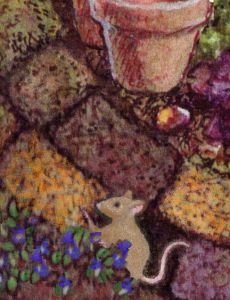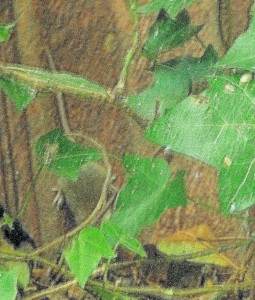The House Mouse
‘The earliest house-mouse records in Europe date from the Iron Age (7th Century BC). So where did these little animals live prior to houses being built? The answer lies probably on the steppes of Central Asia or in the Middle East, both of which have varieties of the species. Needless to say, with so familiar a creature we have a wide range of folklore. Unhappily for the mouse, much of it involves eating. Roasted, boiled or stewed mouse is a remedy for everything from bed-wetting to whooping cough.’
Forgotten Folklore: Myths and Magic in Islington
Richard Meyers for Islington Council
WHO’S BEEN EATING OUR SEEDS?
There were probably house mice in the woodland behind our garden until the developer trashed and burned it. Squirrels were climbing the trees that were felled, cats were using the site as a meeting place and battlefield… mice must have been living in the vegetation. When their playground and larder was destroyed, squirrels, cats and mice were driven to our surrounding houses and gardens. We knew about the squirrels and cats straightaway, but it took awhile to discover the mice. When we planted seeds that never came up, we suspected hungry birds. We blamed slugs and snails for the loss of many plantlets, even without the incriminating slime trails. We hadn’t a clue that mice were living in the garden.
Then, on an episode of Gardeners’ World, Toby Buckland told of missing seedlings in the winter BBC garden. He blamed cold weather and hungry mice. In the soil where the seedlings had been were depressions matching the shape of a mouse’s nose. In the centre of each was a hole where a seedling had germinated, been pulled up and eaten. We wondered whether there could be mice here too, in spite of all the cats in our neighbourhood. But how could mice survive the cats? Once we began looking for mice, we found them.
A mouse was seen on the earthwork, under the Lamium. Weeks later, as we sat at the blue table, another one darted out from behind the pots by the Damson. In broad daylight! It crossed the path and plunged into the wall of old brickwork… working its way along the inner row of bricks, it stopped to look back at us as we watched it…
One morning I saw a bird of prey flapping out of the concrete garden next door with something in its beak, something trailing a long, limp mouselike tail…
Scurvy, who was living in the garden flat, said he’d been at the kitchen sink and seen ‘one of the neighbour’s cats trot by with one of OUR mice in its jaws!’ It leapt onto the fence and was away with its prize. Mice, it seems, are part of the food chain.
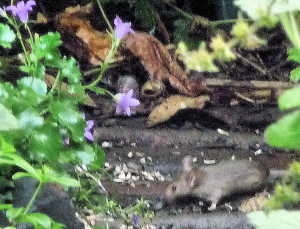
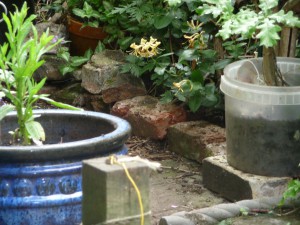
Rhubarb and Custard Mouse on path
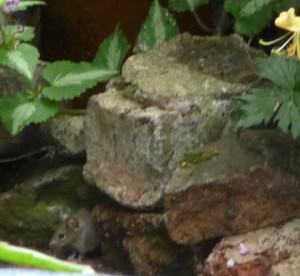
Rhubarb and Custard Mouse closeup
HAVE YOU GOT MICE? YOU CAN HELP BUMBLEBEES
Bumblebees are in decline. They are more than fuzzy harbingers of summer. As pollinators of many of our foods, it is in our own interests to help bring their numbers back up again.
The Bumblebee Conservation Trust has a guide on how to make homes for bumblebees. It tells how to set up a bumblebee home in your garden, with an upturned flower pot, a bit of hosepipe and a few other bits and bobs. Even if mice rather than bumblebees move into your flowerpot house, this will be a good thing. Bumblebees are more likely to set up a nest in a pre-owned mouse house.
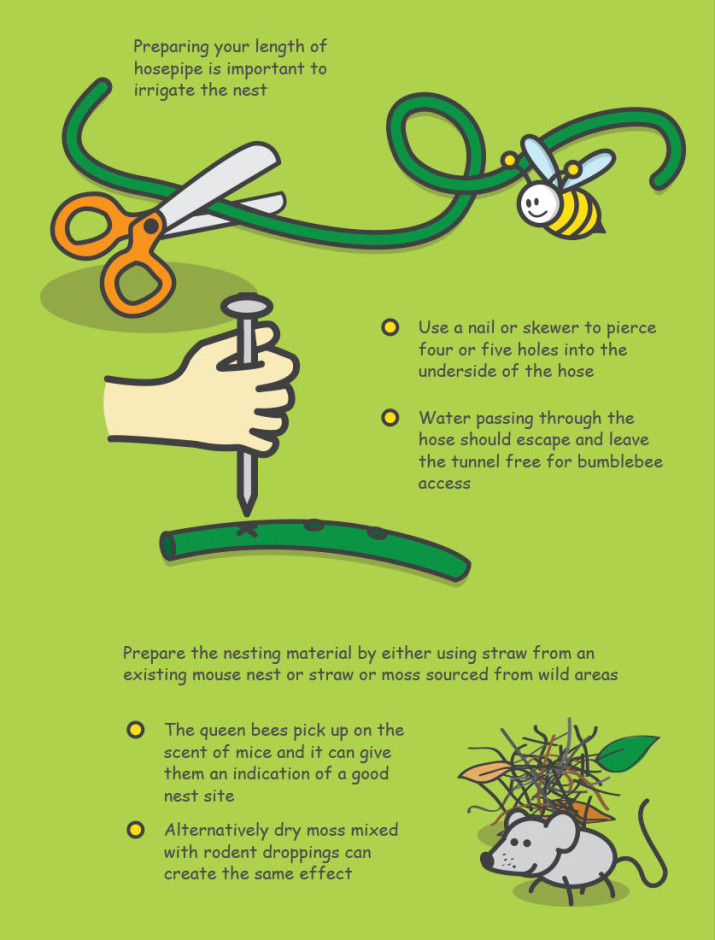
Bee-nesting mouse graphics from BBCT & Hartley Botanic
The characteristic smell of the mouse, it seems, is attractive to the bumblebee. When the mouse leaves its flowerpot home, it will have left behind an aroma that will be enticing to bumblebees. For all you need to know about how to make a bumblebee house, sign up for Bumblebee Conservation UK‘s monthly e magazine
BUZZWORD
You can become a member of The Bumblebee Conservation Trust :
by Email : membership@bumblebeeconservation.org * enquiries@bumblebeeconservation.org volunteering@bumblebeeconservation.org
by Phone : 01786 466 897
by Post : Bumblebee Conservation Trust, Beta Centre, Stirling University Innovation Park, FK9 4NF
For more about the BBCT see our WHAT YOU CAN DO… FOR BEES page

